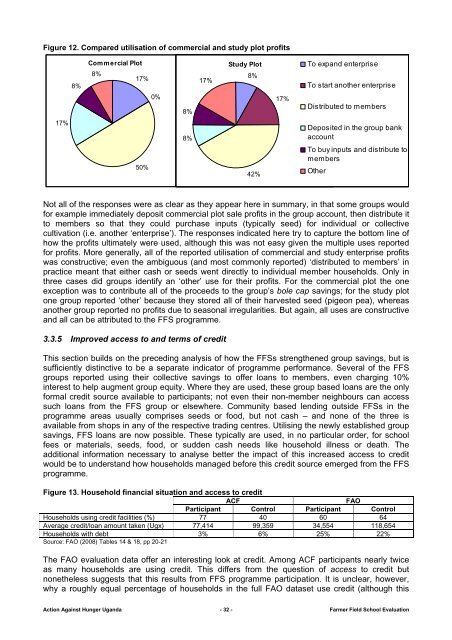Participatory Evaluation of our 2008 - Action Against Hunger
Participatory Evaluation of our 2008 - Action Against Hunger
Participatory Evaluation of our 2008 - Action Against Hunger
You also want an ePaper? Increase the reach of your titles
YUMPU automatically turns print PDFs into web optimized ePapers that Google loves.
Figure 12. Compared utilisation <strong>of</strong> commercial and study plot pr<strong>of</strong>its<br />
8%<br />
Commercial Plot<br />
8%<br />
17%<br />
17%<br />
Study Plot<br />
8%<br />
To expand enterprise<br />
To start another enterprise<br />
0%<br />
8%<br />
17%<br />
Distributed to members<br />
17%<br />
50%<br />
8%<br />
42%<br />
Deposited in the group bank<br />
account<br />
To buy inputs and distribute to<br />
members<br />
Other<br />
Not all <strong>of</strong> the responses were as clear as they appear here in summary, in that some groups would<br />
for example immediately deposit commercial plot sale pr<strong>of</strong>its in the group account, then distribute it<br />
to members so that they could purchase inputs (typically seed) for individual or collective<br />
cultivation (i.e. another ‘enterprise’). The responses indicated here try to capture the bottom line <strong>of</strong><br />
how the pr<strong>of</strong>its ultimately were used, although this was not easy given the multiple uses reported<br />
for pr<strong>of</strong>its. More generally, all <strong>of</strong> the reported utilisation <strong>of</strong> commercial and study enterprise pr<strong>of</strong>its<br />
was constructive; even the ambiguous (and most commonly reported) ‘distributed to members’ in<br />
practice meant that either cash or seeds went directly to individual member households. Only in<br />
three cases did groups identify an ‘other’ use for their pr<strong>of</strong>its. For the commercial plot the one<br />
exception was to contribute all <strong>of</strong> the proceeds to the group’s bole cap savings; for the study plot<br />
one group reported ‘other’ because they stored all <strong>of</strong> their harvested seed (pigeon pea), whereas<br />
another group reported no pr<strong>of</strong>its due to seasonal irregularities. But again, all uses are constructive<br />
and all can be attributed to the FFS programme.<br />
3.3.5 Improved access to and terms <strong>of</strong> credit<br />
This section builds on the preceding analysis <strong>of</strong> how the FFSs strengthened group savings, but is<br />
sufficiently distinctive to be a separate indicator <strong>of</strong> programme performance. Several <strong>of</strong> the FFS<br />
groups reported using their collective savings to <strong>of</strong>fer loans to members, even charging 10%<br />
interest to help augment group equity. Where they are used, these group based loans are the only<br />
formal credit s<strong>our</strong>ce available to participants; not even their non-member neighb<strong>our</strong>s can access<br />
such loans from the FFS group or elsewhere. Community based lending outside FFSs in the<br />
programme areas usually comprises seeds or food, but not cash – and none <strong>of</strong> the three is<br />
available from shops in any <strong>of</strong> the respective trading centres. Utilising the newly established group<br />
savings, FFS loans are now possible. These typically are used, in no particular order, for school<br />
fees or materials, seeds, food, or sudden cash needs like household illness or death. The<br />
additional information necessary to analyse better the impact <strong>of</strong> this increased access to credit<br />
would be to understand how households managed before this credit s<strong>our</strong>ce emerged from the FFS<br />
programme.<br />
Figure 13. Household financial situation and access to credit<br />
ACF<br />
FAO<br />
Participant Control Participant Control<br />
Households using credit facilities (%) 77 40 60 64<br />
Average credit/loan amount taken (Ugx) 77,414 99,359 34,554 118,654<br />
Households with debt 3% 6% 25% 22%<br />
S<strong>our</strong>ce: FAO (<strong>2008</strong>) Tables 14 & 18, pp 20-21<br />
The FAO evaluation data <strong>of</strong>fer an interesting look at credit. Among ACF participants nearly twice<br />
as many households are using credit. This differs from the question <strong>of</strong> access to credit but<br />
nonetheless suggests that this results from FFS programme participation. It is unclear, however,<br />
why a roughly equal percentage <strong>of</strong> households in the full FAO dataset use credit (although this<br />
<strong>Action</strong> <strong>Against</strong> <strong>Hunger</strong> Uganda - 32 - Farmer Field School <strong>Evaluation</strong>

















